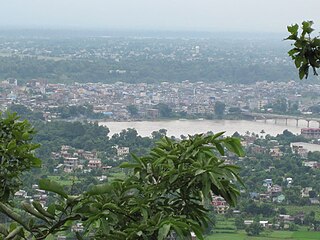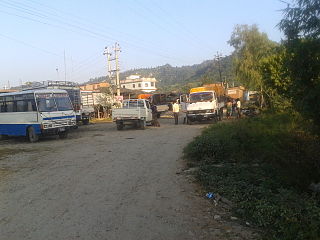
Mapusa is a city in North Goa, India. It is situated 13 km north of the state capital of Panaji. The city is the headquarters of Bardez taluka. It is located on the main highway NH-17, linking Mumbai to Kochi. During Portuguese India, the city was known as "Mapuçá".

Chitwan District is one of 77 districts of Nepal, and takes up the southwestern corner of Bagmati Province. Bharatpur, largest city of Nepal after Kathmandu, is its administrative centre. It covers 2,238.39 km2 (864.25 sq mi), and in 2011 had a population of 579,984 people. Bharatpur is the commercial and service centre of South Central Nepal and a major destination for higher education, health care and transportation in the region. Chitwan lies in the Terai region of Nepal. It is in the drainage basin of the Gandaki River and is roughly triangular, taking that river as its meandering northwestern border, and a modest watershed border, with India, as the basis of its southern limit. Local government: Bharatpur Metropolitan, Rapti Municipality, Ratnanagar Municipality, Kalika Municipality, Khairahani Municipality, Madi Municipality, Ikshyakamana Gaupalika

Mahendranagar, officially known as Bhimdattanagar, is a municipality in Kanchanpur District of Sudurpashchim Province, Nepal. The city and the municipality were named Mahendranagar in honour of the late King Mahendra of Nepal. After becoming a republic in 2008, the Mahendranagar municipality name was changed to Bhimdatta municipality in honour of the revolutionary farmer leader Bhimdatta Panta. It is surrounded by Bedkot Municipality in the east, Dadeldhura District in the north, Shuklaphanta National Park in the south and Uttarakhand, India in the west.

Janakpurdham or Janakpur, is a sub-metropolitan city in Dhanusha district, Madhesh Province, Nepal. The city is a hub for religious and cultural tourism. A headquarter of Dhanusha district, Janakpur is also the capital for Madhesh Province.

Budhabare, more specifically Hadiya Budhabare, is a village and former Village Development Committee that is now part of Buddhashanti Rural Municipality in Jhapa district of Province No. 1 in south-eastern Nepal. The latest official data, 2011 Nepal Census, puts the total population of the VDC at 22,936. Owing to this average population size, the VDC has been divided into nine wards.

Khiji Chandeshwari खिँजी/खिँचि, Chandeshowar mispronounce Chandeshwari or Original Name Khiji (jee/chee/ji) and Chandi-Showar became Chandeshwari खिजी चण्डेश्वरी is a village development committee in Okhaldhunga District in the Sagarmatha Zone of mid-eastern Nepal. At the time of the 1991 Nepal census it had a population of 3001 living in 590 individual households.

Hariwan is a town and municipality in Nepal, located in Sarlahi District. The municipality is surrounded by Lalbandi municipality in the East and Bagmati municipality in the West, Hariharpurgadhi municipality of Sindhuli District, Bagmati Province falls in the North and Haripur in the South. It is formed by the joining of four contemporary Village development committees (VDCs) namely Atrouli, Sasapur, Ghurkauli and Harion VDCs covering an area of 88.1 km2. It has been divided into 11 wards with an administration center in Harion Bazar. According to Nepal Population Census 2011, the municipality has a total population of 42,783.
Sangrampur is a Village Development Committee in Sarlahi District in the Janakpur Zone of south-eastern Nepal. Now, It is a part of Parsa Rural Municipality. It is the 2nd ward of this Rural Municipality. At the time of the 1991 Nepal census it had a population of 4,491 people residing in 769 individual households.
Hadiya, Nepal is a village development committee in Udayapur District in the Sagarmatha Zone of south-eastern Nepal. At the time of the 2011 Nepal census it had a population of 11331 people living in 2355 individual households. Cheetri and Bharmin is the major ethnic community with huge population while Magars, Sunuwar, Newar, Tharu and Madhesi are ethnic minorities living in the village.
Jhutaki is a village development committee in Saptari District in the Sagarmatha Zone of south-eastern Nepal. At the time of the 1991 Nepal census it had a population of 8,000 people living in 800 individual households. Different caste people like Yadav, mandal, sha, ram, mallah, sharma, dom, shada etc., used to live in village. It consists of four subvillages. It has three small bazaars but it does not have good road facility.[1] Most of the people are farmers and they grow paddy, wheat, pulses, vegetables, etc. Some of the people used to depend on animal husbandry and fishery to survive. Economy Most of the people involved in farming, animal husbandry and fishing.
Beldandi is a rural municipality in Kanchanpur District in Sudurpashchim Province of southwestern Nepal named after the former Village Development Committee. At the time of the 1991 Nepal census the VDC had a population of 9301 people living in 1483 individual households. According to the Nepal census 2011 the municipality had 3022 individual households and a population of 21,959. In the north and west, Beldandi is surrounded by Suklaphatha national park. To the east lies Belauri Municipality. On the south, it borders India.

Tahoon is a village very development committee in Palpa District in the Lumbini Zone of southern Nepal. At the time of the 1991 Nepal census it had a population of 3776.
Meghauli is a small city and former Village Development Committee that is now part of Bharatpur Metropolitan City in Bagmati Province of central Nepal.

Kawasoti (Nepali: कावासोती) is a municipality in Nawalpur District, Gandaki Province, Nepal. It is 31 km (19 mi) west of Bharatpur and 85 km (53 mi) east of Butwal, approximately on the middle of Mahendra Highway. The Naryani River flows south of it, and the Mahabharat Range is north of it.
Sureban is a village in Belgaum district of Northern Karnataka, India. Usually the place is referred to as Sureban-Manihal. They are separate villages, but in spirit are the same.
Manik Chowk is a village in the Indian state of Bihar.

Khayarmara नेपाली: खयरमारा is a part of Janakpur Zone Mahottari district in Nepal. It is within the VDC. It is 7 kilometres (4.3 mi) north from Mahendra Highway. It touches many areas together with Sindhuli to North and Sarlahi to west.
Bhramarpura भ्रमरपुर is a village six kilometers west of Janakpurdham. It is the most populous village in its district. Bhramarpura is located in the Loharpatti Municipality 7, Mahottari district of Janakpur Zone of Nepal. This village has a high income because 25% of the village population is working overseas. At the time of the 2011 Nepal census, the village had a population of 9458 people living in 1734 individual households. In Dhanusha district where this village has left it name in that city calling as a Bhramarpura Chowk. People living in this village are following different religions, most of the people living in this village are Hindu or Muslim. In Hindu the castes are Brahmin, Yadav, Teli, Sudhi, Mandal, etc. In Muslim [[Dhobi][Rain people|Rain]], Nadaf, among others.

Dakneshwori Municipality is located in Saptari District in Madhesh Province of Nepal. It was formed in 2016 occupying current 10 sections (wards) merging previous Kabilasha, Hariraha, Tarhi, Bhuthi, Pato, Aurahi, Brahampur, Gamahariya Parwaha, Patthargada and Banaula VDCs. It occupies an area of 69.11 km2 with a total population of 44,782. Dakneshwori Municipality is named after the famous temple Dakneshwori Bhagwati located at ward no. 5, Pato.
Agnisaira Krishnasavaran is a rural municipality in Saptari District in the Sagarmatha Zone of south-eastern Nepal. At the time of the 2017 Nepal census it had a population of 27,129 people living in 2265 individual households.











